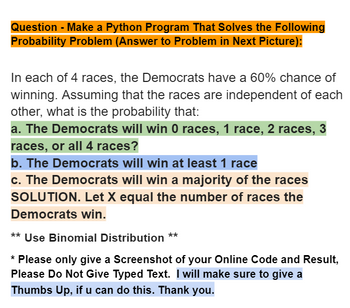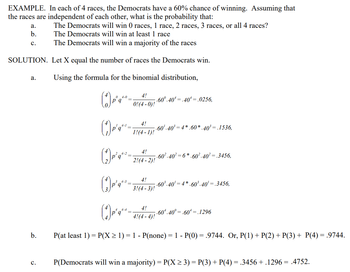
Database System Concepts
7th Edition
ISBN: 9780078022159
Author: Abraham Silberschatz Professor, Henry F. Korth, S. Sudarshan
Publisher: McGraw-Hill Education
expand_more
expand_more
format_list_bulleted
Question
thumb_up100%
Hello. Please create a Python Program that solves the following Probability question (Answer to question is in the other Pic). Please Only Give a Screenshot of your Online Code & Result. Please Do Not Give Typed Text.
* If you can do this, I will definitely give you a thumbs up. Thank you!

Transcribed Image Text:Question - Make a Python Program That Solves the Following
Probability Problem (Answer to Problem in Next Picture):
In each of 4 races, the Democrats have a 60% chance of
winning. Assuming that the races are independent of each
other, what is the probability that:
a. The Democrats will win 0 races, 1 race, 2 races, 3
races, or all 4 races?
b. The Democrats will win at least 1 race
c. The Democrats will win a majority of the races
SOLUTION. Let X equal the number of races the
Democrats win.
** Use Binomial Distribution **
* Please only give a Screenshot of your Online Code and Result,
Please Do Not Give Typed Text. I will make sure to give a
Thumbs Up, if u can do this. Thank you.

Transcribed Image Text:EXAMPLE. In each of 4 races, the Democrats have a 60% chance of winning. Assuming that
the races are independent of each other, what is the probability that:
The Democrats will win 0 races, 1 race, 2 races, 3 races, or all 4 races?
The Democrats will win at least 1 race
a.
b.
C.
The Democrats will win a majority of the races
SOLUTION. Let X equal the number of races the Democrats win.
a.
Using the formula for the binomial distribution,
(p'q"
4!
0!(4-0)!
.60°.40* = .40* = .0256,
O p q
4!
··60'.40³ = 4*.60*.40³ = .1536,
1!(4-1)!
b.
(3) p² q =
(3 p q
4!
·60².40²=6*.60².40² = .3456,
2!(4-2)!
=
4!
·60³.40'=4*.60³.40' = .3456,
3!(4-3)!
4!
=
.60*.40°= .60*=.1296
4!(4-4)!
P(at least 1) = P(X ≥ 1) = 1 - P(none) = 1 - P(0) = .9744. Or, P(1) + P(2) + P(3) + P(4) = .9744.
C.
P(Democrats will win a majority) = P(X ≥ 3) = P(3) + P(4) = .3456 + .1296 = .4752.
Expert Solution
This question has been solved!
Explore an expertly crafted, step-by-step solution for a thorough understanding of key concepts.
Step by stepSolved in 4 steps with 2 images

Knowledge Booster
Learn more about
Need a deep-dive on the concept behind this application? Look no further. Learn more about this topic, computer-science and related others by exploring similar questions and additional content below.Similar questions
- Any help with this question is greatly appreciated!! Please include screenshots of the code if possible. Thank you!! This is my last question, if possible could I have help with the five sub parts? I know it is usually only 3 sub parts. It would really mean a lot! Thank you!! 1. For this question please write a python coded program for each concept displaying how each one is done. Create it any way you would like and explain your code. -read a file and put some content into a variables-how to create a list of strings-printing the list of strings-how to sort list-select middle few in list to make another listarrow_forwardHello. Please create a Python Program for the following question on Probability. Please Only Provide a Screenshot of the Code & result.* If you can do this, I will give you a thumbs up. Thank you!arrow_forwardwriting Python programs that use simple arithmeticexpressions. Follow below to write a simple Python program tosolve riddles like this one:Bush and Laura have 10 apples between them. Bush has 2 moreapples than Laura. How many apples does each have? Type the following in your editor window (the one labeled"Python Script"): input("How many apples are there in all?") We need to capture the value returned byinput() so that we can do something with it. We'll dothis by storing the result in a variable named "total_apples": total_apples = input("How many apples are there inall?") Translate this formula into Python. Start by assigning (total - 2)to a temporary variable. Divide the value of this variable by 2 andstore the result in a new variable for the first child. Add thedifference (2) to this value and store it in a new variable for thesecond child. We're almost done. Now that our calculations are finished, weshould print the results for the user. We can use theprint…arrow_forward
- Hello. Please create a Python Program that solves the following question on Probability (Answer to question is in the other Pic). Please Only Give a Screenshot of your Online Code & Result. Please Do Not Give Typed Text. * If you can do this, I will definitely give you a thumbs up. Thank you!arrow_forwardDO NOT COPY FROM OTHER WEBSITES Code with comments and output screenshot is must for an Upvote. Thank you!arrow_forwardHello. Please create a Python Program for following question on Probability (Solution to question in other pic). Please Only Write Your Code On Paper and provide a screenshot of this and the result. * If you can do this and correctly answer, I will give you a thumbs up. Thanks!arrow_forward
arrow_back_ios
arrow_forward_ios
Recommended textbooks for you
 Database System ConceptsComputer ScienceISBN:9780078022159Author:Abraham Silberschatz Professor, Henry F. Korth, S. SudarshanPublisher:McGraw-Hill Education
Database System ConceptsComputer ScienceISBN:9780078022159Author:Abraham Silberschatz Professor, Henry F. Korth, S. SudarshanPublisher:McGraw-Hill Education Starting Out with Python (4th Edition)Computer ScienceISBN:9780134444321Author:Tony GaddisPublisher:PEARSON
Starting Out with Python (4th Edition)Computer ScienceISBN:9780134444321Author:Tony GaddisPublisher:PEARSON Digital Fundamentals (11th Edition)Computer ScienceISBN:9780132737968Author:Thomas L. FloydPublisher:PEARSON
Digital Fundamentals (11th Edition)Computer ScienceISBN:9780132737968Author:Thomas L. FloydPublisher:PEARSON C How to Program (8th Edition)Computer ScienceISBN:9780133976892Author:Paul J. Deitel, Harvey DeitelPublisher:PEARSON
C How to Program (8th Edition)Computer ScienceISBN:9780133976892Author:Paul J. Deitel, Harvey DeitelPublisher:PEARSON Database Systems: Design, Implementation, & Manag...Computer ScienceISBN:9781337627900Author:Carlos Coronel, Steven MorrisPublisher:Cengage Learning
Database Systems: Design, Implementation, & Manag...Computer ScienceISBN:9781337627900Author:Carlos Coronel, Steven MorrisPublisher:Cengage Learning Programmable Logic ControllersComputer ScienceISBN:9780073373843Author:Frank D. PetruzellaPublisher:McGraw-Hill Education
Programmable Logic ControllersComputer ScienceISBN:9780073373843Author:Frank D. PetruzellaPublisher:McGraw-Hill Education

Database System Concepts
Computer Science
ISBN:9780078022159
Author:Abraham Silberschatz Professor, Henry F. Korth, S. Sudarshan
Publisher:McGraw-Hill Education

Starting Out with Python (4th Edition)
Computer Science
ISBN:9780134444321
Author:Tony Gaddis
Publisher:PEARSON

Digital Fundamentals (11th Edition)
Computer Science
ISBN:9780132737968
Author:Thomas L. Floyd
Publisher:PEARSON

C How to Program (8th Edition)
Computer Science
ISBN:9780133976892
Author:Paul J. Deitel, Harvey Deitel
Publisher:PEARSON

Database Systems: Design, Implementation, & Manag...
Computer Science
ISBN:9781337627900
Author:Carlos Coronel, Steven Morris
Publisher:Cengage Learning

Programmable Logic Controllers
Computer Science
ISBN:9780073373843
Author:Frank D. Petruzella
Publisher:McGraw-Hill Education